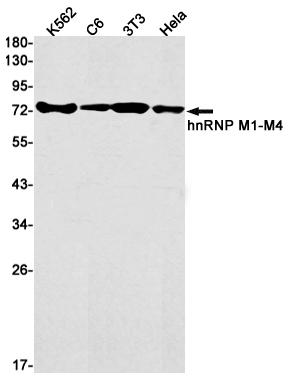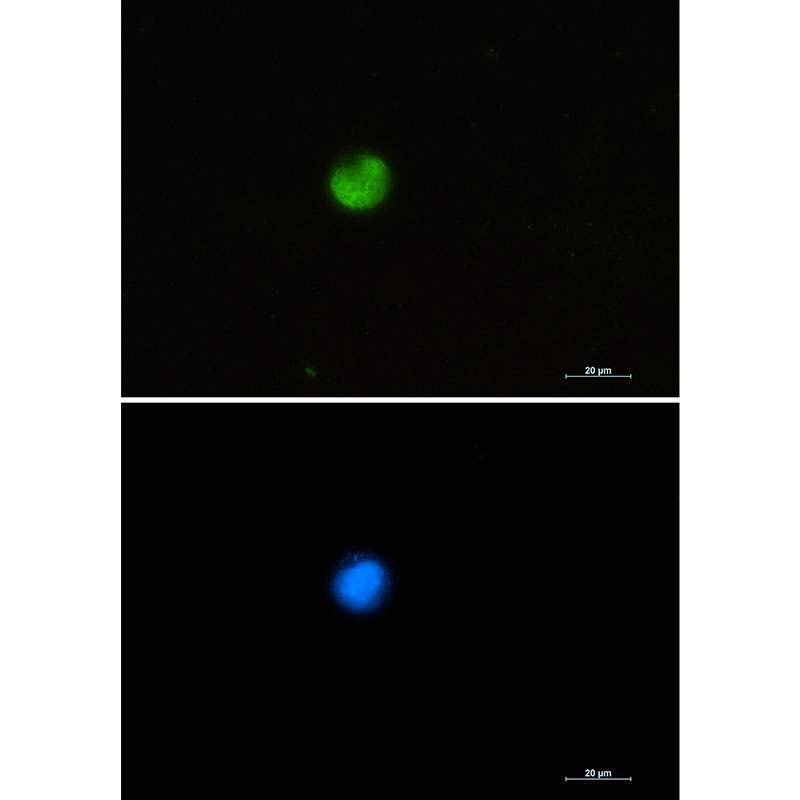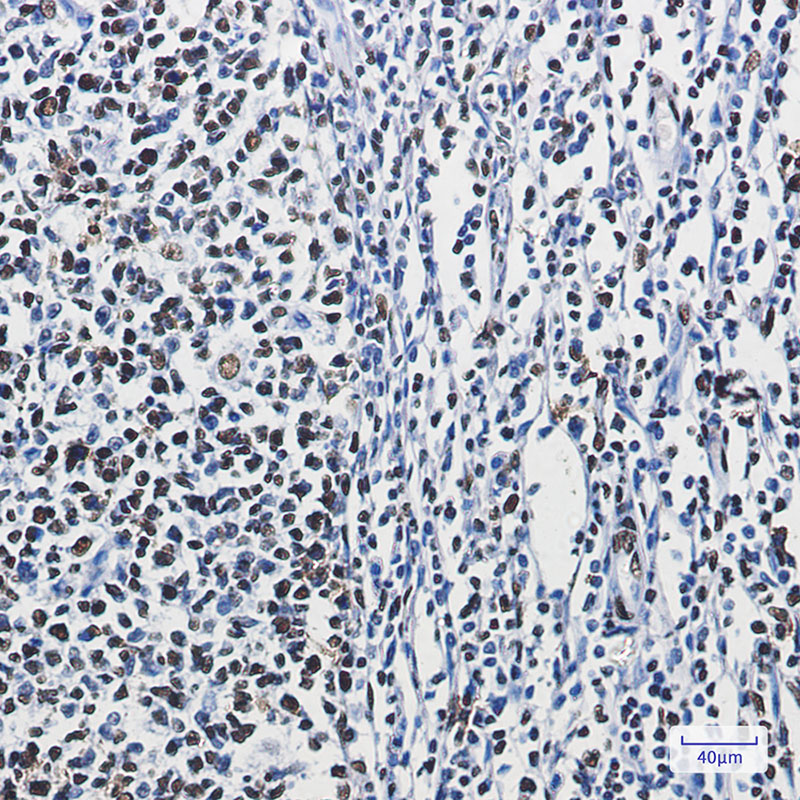


| WB | 1/500-1/1000 | Human,Mouse,Rat |
| IF | 咨询技术 | Human,Mouse,Rat |
| IHC | 1/50-1/100 | Human,Mouse,Rat |
| ICC | 1/50-1/200 | Human,Mouse,Rat |
| FCM | 咨询技术 | Human,Mouse,Rat |
| Elisa | 咨询技术 | Human,Mouse,Rat |
| Aliases | CEAR; HNRPM; HTGR1; NAGR1; HNRPM4; HNRNPM4; hnRNP M |
| Entrez GeneID | 4670 |
| WB Predicted band size | Calculated MW: 78 kDa; Observed MW: 78 kDa |
| Host/Isotype | Rabbit IgG |
| Antibody Type | Primary antibody |
| Storage | Store at 4°C short term. Aliquot and store at -20°C long term. Avoid freeze/thaw cycles. |
| Species Reactivity | Human,Mouse,Rat |
| Immunogen | A synthetic peptide of human hnRNP M1-M4 |
| Formulation | Purified antibody in TBS with 0.05% sodium azide,0.05%BSA and 50% glycerol. |
+ +
以下是关于hnRNP M抗体的3篇参考文献及其简要摘要:
1. **"Heterogeneous nuclear ribonucleoprotein M facilitates recruitment of 20S proteasome to stress granules"**
*作者:Y. Liu et al.*
**摘要**:该研究利用hnRNP M抗体进行免疫共沉淀和免疫荧光实验,发现hnRNP M在细胞应激条件下通过与20S蛋白酶体亚基相互作用,促进蛋白酶体向应激颗粒的招募,揭示了其在蛋白质质量控制中的新功能。
2. **"hnRNP M modulates the alternative splicing of apoptotic genes in non-small cell lung cancer"**
*作者:K. Chen et al.*
**摘要**:通过Western blot和RNA免疫沉淀(RIP)结合hnRNP M抗体,研究发现hnRNP M在非小细胞肺癌中调控促凋亡基因(如CASP2)的可变剪接,其表达水平与患者预后显著相关。
3. **"Interaction of hnRNP M with long non-coding RNA MALAT1 in cancer metastasis"**
*作者:S. Wang et al.*
**摘要**:该文献利用hnRNP M抗体进行ChIP-seq和RNA pull-down实验,证实hnRNP M与长链非编码RNA MALAT1结合,通过调控EMT相关基因剪接促进肿瘤转移,为癌症治疗提供了潜在靶点。
4. **"Co-localization of hnRNP M and TDP-43 in ALS neuronal inclusions"**
*作者:J. Park et al.*
**摘要**:研究通过免疫组化结合hnRNP M抗体,发现肌萎缩侧索硬化症(ALS)患者神经元中hnRNP M与TDP-43病理蛋白共定位,提示其可能参与神经退行性病变的RNA代谢异常机制。
以上文献均通过hnRNP M抗体阐明了该蛋白在RNA代谢、疾病机制中的关键作用。
**Background of hnRNP M Antibody**
Heterogeneous nuclear ribonucleoprotein M (hnRNP M) is a member of the hnRNP family, which plays critical roles in RNA processing, including pre-mRNA splicing, transport, stability, and translation regulation. The hnRNP M protein contains RNA-binding domains that enable interaction with specific RNA sequences, influencing splice site selection and gene expression.
hnRNP M antibodies are essential tools for studying the protein's function and localization. They are widely used in techniques like Western blotting, immunoprecipitation, and immunofluorescence to detect hnRNP M expression levels, protein-RNA interactions, and subcellular distribution. Research has linked hnRNP M to various cellular processes, such as DNA damage response, cell cycle regulation, and viral RNA processing. Dysregulation of hnRNP M has been implicated in diseases, including cancers (e.g., leukemia, colorectal cancer) and neurodegenerative disorders, highlighting its potential as a diagnostic or therapeutic target.
These antibodies are typically validated for specificity across species (human, mouse, rat) and applications. Commercial hnRNP M antibodies are often raised against conserved epitopes, ensuring broad utility in both basic and translational research. Recent studies also explore hnRNP M's role in alternative splicing of cancer-related genes, underscoring its importance in precision medicine and molecular pathology.
×